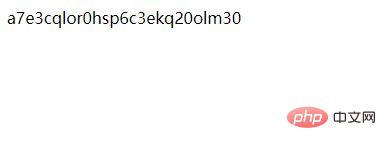 Backend Development
Backend Development
 PHP Problem
PHP Problem
 What are the types of scopes in PHP? What area can be accessed by the scope?
What are the types of scopes in PHP? What area can be accessed by the scope?
What are the types of scopes in PHP? What area can be accessed by the scope?
The previous article introduced you to "What is the difference between cookie and session in PHP? 》, this article continues to introduce to you what are the types of scopes in PHP? What area can be accessed by the scope? It has certain reference value. Friends in need can refer to it. I hope it will be helpful to everyone.

#Scope: The area that a variable (constant) can access.
1. The volume can be defined in ordinary code.
2. Variables can also be defined inside the function.
Strictly speaking, functions in PHP are divided into two types: However, PHP also defines some internal ones that are outside the strict sense, so there are three types in total:.
1. Global volume: It is the volume generally defined by the user (the number of groups is defined externally).
Belongs to the global space: In PHP, it is only allowed to be used in the global space: theoretically, it cannot be used inside the function.
Script cycle: until the end of the script (the last line of code is executed).
2. Local intersection: It is the variable defined inside the return number.
The current warp number space it belongs to: in PHP, it is only allowed to be used within the current warp number itself.
Function cycle: Function execution ends (the function opens an independent memory space in the stack area to run).
3. Super global variables: system-defined variables (predefined variables: s. SERVER, s. POST, etc.).
The super-global space it belongs to: no access restrictions (can be accessed both inside and outside the function).
Specifically, we take the code as an example:
In PHP scope, the default code space is the global space. We use global to define global variables. What we define Variables will be included in superglobal variables by the system. Local variables are defined inside the function. First, the function function is defined (all formal parameters can be understood as local variables), and then inner is output. Secondly, we access the global variable. ;
<?php
//PHP中作用域
//默认的代码空间:全局空间
$global = 'global area' ;
//局部变量(函数内部定义)=global area;
function display(){
//所有的形参都可以理解为局部变量
$inner = __FUNCTION__ ;
//访问全局变量
echo $global ;
}
//调用函数
display();The code results are as follows:

We see that the result shows that there is no global variable, which means that we access the global system and report an error when calling the function, but In fact, we have already defined it, indicating that global variables cannot be used in local space.
Recommended learning: php video tutorial
The above is the detailed content of What are the types of scopes in PHP? What area can be accessed by the scope?. For more information, please follow other related articles on the PHP Chinese website!

Hot AI Tools

Undresser.AI Undress
AI-powered app for creating realistic nude photos

AI Clothes Remover
Online AI tool for removing clothes from photos.

Undress AI Tool
Undress images for free

Clothoff.io
AI clothes remover

AI Hentai Generator
Generate AI Hentai for free.

Hot Article

Hot Tools

Notepad++7.3.1
Easy-to-use and free code editor

SublimeText3 Chinese version
Chinese version, very easy to use

Zend Studio 13.0.1
Powerful PHP integrated development environment

Dreamweaver CS6
Visual web development tools

SublimeText3 Mac version
God-level code editing software (SublimeText3)

Hot Topics
 1378
1378
 52
52
 Usage of typedef struct in c language
May 09, 2024 am 10:15 AM
Usage of typedef struct in c language
May 09, 2024 am 10:15 AM
typedef struct is used in C language to create structure type aliases to simplify the use of structures. It aliases a new data type to an existing structure by specifying the structure alias. Benefits include enhanced readability, code reuse, and type checking. Note: The structure must be defined before using an alias. The alias must be unique in the program and only valid within the scope in which it is declared.
 How to solve variable expected in java
May 07, 2024 am 02:48 AM
How to solve variable expected in java
May 07, 2024 am 02:48 AM
Variable expected value exceptions in Java can be solved by: initializing variables; using default values; using null values; using checks and assignments; and knowing the scope of local variables.
 Advantages and disadvantages of closures in js
May 10, 2024 am 04:39 AM
Advantages and disadvantages of closures in js
May 10, 2024 am 04:39 AM
Advantages of JavaScript closures include maintaining variable scope, enabling modular code, deferred execution, and event handling; disadvantages include memory leaks, increased complexity, performance overhead, and scope chain effects.
 What does include mean in c++
May 09, 2024 am 01:45 AM
What does include mean in c++
May 09, 2024 am 01:45 AM
The #include preprocessor directive in C++ inserts the contents of an external source file into the current source file, copying its contents to the corresponding location in the current source file. Mainly used to include header files that contain declarations needed in the code, such as #include <iostream> to include standard input/output functions.
 C++ smart pointers: a comprehensive analysis of their life cycle
May 09, 2024 am 11:06 AM
C++ smart pointers: a comprehensive analysis of their life cycle
May 09, 2024 am 11:06 AM
Life cycle of C++ smart pointers: Creation: Smart pointers are created when memory is allocated. Ownership transfer: Transfer ownership through a move operation. Release: Memory is released when a smart pointer goes out of scope or is explicitly released. Object destruction: When the pointed object is destroyed, the smart pointer becomes an invalid pointer.
 Can the definition and call of functions in C++ be nested?
May 06, 2024 pm 06:36 PM
Can the definition and call of functions in C++ be nested?
May 06, 2024 pm 06:36 PM
Can. C++ allows nested function definitions and calls. External functions can define built-in functions, and internal functions can be called directly within the scope. Nested functions enhance encapsulation, reusability, and scope control. However, internal functions cannot directly access local variables of external functions, and the return value type must be consistent with the external function declaration. Internal functions cannot be self-recursive.
 There are several situations where this in js points to
May 06, 2024 pm 02:03 PM
There are several situations where this in js points to
May 06, 2024 pm 02:03 PM
In JavaScript, the pointing types of this include: 1. Global object; 2. Function call; 3. Constructor call; 4. Event handler; 5. Arrow function (inheriting outer this). Additionally, you can explicitly set what this points to using the bind(), call(), and apply() methods.
 The difference between let and var in vue
May 08, 2024 pm 04:21 PM
The difference between let and var in vue
May 08, 2024 pm 04:21 PM
In Vue, there is a difference in scope when declaring variables between let and var: Scope: var has global scope and let has block-level scope. Block-level scope: var does not create a block-level scope, let creates a block-level scope. Redeclaration: var allows redeclaration of variables in the same scope, let does not.



